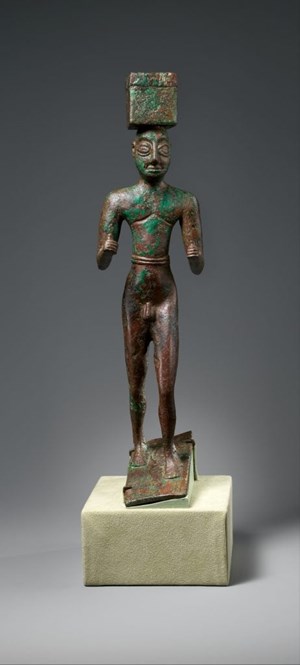
The Met initiated the return of the Early Dynastic figurative sculpture after provenance research by Met scholars established that the work rightfully belongs to Iraq.
The Metropolitan Museum of Art and the Republic of Iraq announced today that The Met has repatriated a third-millennium BCE Sumerian sculpture—the copper alloy depiction of a man carrying a box, possibly for offerings—to the Republic of Iraq. The repatriation was marked by a ceremony in Washington D.C. with the Prime Minister of the Republic of Iraq, His Excellency Mohamed Shia’ Al Sudani; Ambassador of the Republic of Iraq to the United States of America, His Excellency Nazar Al Khirullah; United States Ambassador to Iraq, Alina L. Romanowski; and from The Met, Andrea Bayer, Deputy Director for Collections and Administration; and Kim Benzel, Curator in Charge, Department of Ancient Near Eastern Art.
The Met purchased the statue in 1955. After provenance research by the Museum’s scholars established that the work rightfully belongs to the Republic of Iraq, the Museum met with H.E. Nazar Al Khirullah, Ambassador of the Republic of Iraq to the United States of America, and offered to return the work. The repatriation follows the launch of The Met’s Cultural Property Initiative last year.
“The Met is committed to the responsible collecting of antiquities and to the shared stewardship of the world’s cultural heritage,” said Max Hollein, The Met’s Director and Chief Executive Officer. “We are honored to collaborate with the Republic of Iraq on the return of this sculpture, and we value the important relationships we have fostered with our colleagues there. We look forward to continuing the ongoing and open dialogue between us.” Temples were the most important institutions in Mesopotamian cities of the Early Dynastic period (2900–2350 BCE). Each city had a patron deity, whose temple was built on a large platform and was visible for great distances in the flat countryside. The temple was literally a house for the god and a place of ritual, but it was also the most significant economic institution of the time, with large numbers of laborers to work its fields, produce goods for use in the temple, and trade with distant lands. Temple building had its own series of rituals, including purifying the ground on which the temple would stand and dedicating foundation deposits to the resident god.
The figure of a nude man carrying a box on his head is a fine example of Sumerian sculpture in metal. Only certain categories of people were represented as nude in the Early Dynastic period: priests, athletes, mythological heroes, and prisoners of war. This figure, reminiscent of scenes depicting priests carrying offerings, carries an object that might be a temple foundation deposit or an offering related to its building.
Main Image :Ancient Sumerian sculpture. Photo courtesy of the Metropolitan Museum of Art

ArtDependence Magazine is an international magazine covering all spheres of contemporary art, as well as modern and classical art.
ArtDependence features the latest art news, highlighting interviews with today’s most influential artists, galleries, curators, collectors, fair directors and individuals at the axis of the arts.
The magazine also covers series of articles and reviews on critical art events, new publications and other foremost happenings in the art world.
If you would like to submit events or editorial content to ArtDependence Magazine, please feel free to reach the magazine via the contact page.